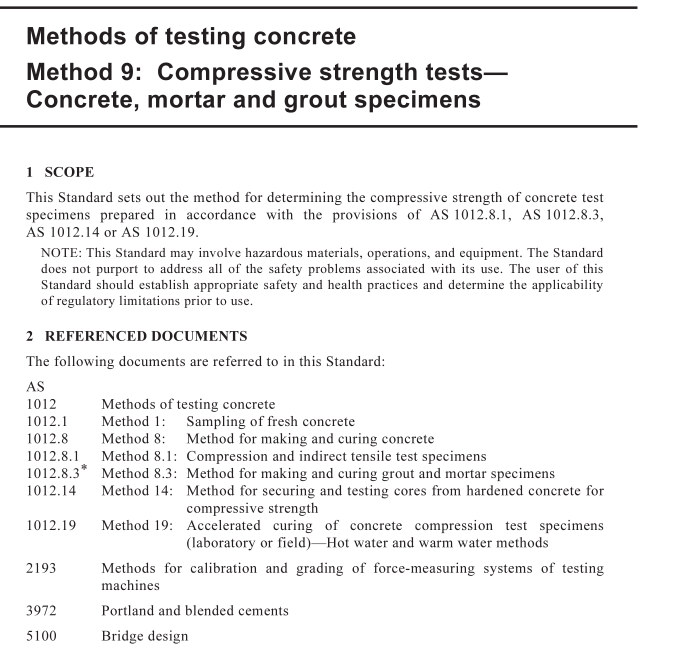AS 1012.9 pdf download – Methods of testing concrete Method 9: Compressive strength tests— Concrete, mortar and grout specimens

AS 1012.9 pdf download – Methods of testing concrete Method 9: Compressive strength tests— Concrete, mortar and grout specimens
4 ACCEPTANCE OF SPECIMENS4.1Moulded cylinder specimens
Moulded cylinder specimens shall be accepted for testing if they have been moulded inaccordance with AS 1012.8.1 and are free from defects likely to affect their strength.
Where specimens liable to rejection are tested, all apparent defects shall be noted inaccordance with Clauses 1 1 and 12 herein.
Uncapped specimens shall be liable to rejection if any of the following conditions exist:(a) Either end of a cylinder is convex by more than 5 mm.
(b)Aggregate or other bulges protrude from either end by more than 5 mm.
(c)Any edge is broken away in such a manner that the radial or vertical break is more
than 10 mm from the edge line and the corresponding circumferential break,or sumof circumferential breaks, exceeds 10% of the circumference of the cylinder.
(d)
Small depressions or other irregularities are present which would cause filled sulphurmixture caps complying with Clause 6.2.1 to be more than 6 mm thick over more thanapproximately 25% of the surface,except that such specimens shall not be liable torejection if they are to be capped in accordance with Clause 6.2.4(a).
(e) Either end of a cylinder is not at right angles to the axis and the departure from
squareness exceeds 2 (approximately 5 mm in 150 mm).
(f)The diameter at any cross-section deviates from either end diameter by more than
2 mm.
(g) The height is less than 1.95 times the diameter.
(h)Any apparent defect is considered liable to affect the test results.4.2Cored specimens
The relevant criteria of AS 1012.14 shall be used to determine acceptability of coredspecimens.
4.3Cube specimens
The sides of the cube specimens which are to be loaded shall be at right angles and be flatto within 0.05 mm.
5 PREPARATION OF TEST SPECIMENSTest specimens shall be prepared as follows:
(a)lf the surfaces of test specimens that are to be brought into contact with the platens of
the testing machine are not plane within 0.05 mm they shall be either—
(i)capped (moulded cylinders or cores); or
(i)ground plane within 0.05 mm.(See Appendix A).
The ends of the specimens that will be in contact with the platens shall be parallelwithin 20.
(b)An uncapped end of a cylinder specimen,which is to be placed in contact with the
testing machine platen that is not spherically seated, or the surface of a cap similarlyplaced,shall not depart from perpendicularity to the axis of the specimen by morethan 0.5 °(approximately 3 mm in 300 mm).
(d)Specimens that are to be tested in the wet condition shall be kept moist during the
time taken for inspection, measuring, capping and crushing. The maximum period oftime a specimen is kept outside standard moist-curing conditions shall not exceed 2 h.(c)Cored specimens that are to be tested in the dry condition shall be tested within 2 h of
removal from the conditioning environment.
6CAPPING
6.1General
Where capping is required, the specimens shall be tested using either—(a)a moulded capping, prepared in accordance with Clause 6.2 ; or
(b)a restrained natural rubber capping system complying with the requirements of
Clause 6.3, provided compressive strength is expected to be greater than 10 MPa andless than 80 MPa.
6.2Moulded capping materials6.2.1General
Moulded caps shall be as thin as practicable, but not thicker than 6 mm. Only one layer ofcapping material shall be used on each surface requiring capping,but small depressionsmay be filled prior to capping. Moulded capped surfaces shall not depart from a plane bymore than 0.05 mm.
6.2.2 Preparation of capping materials
Moulded capping materials shall consist of one of the following, subject to the limitationson use set out in Clause 6.4:
(a)Filled sulphur mixtures Mixtures of sulphur and at least 10% by volume of fine
filler material such as fly ash,finely ground silica or fire clay,or cement may beprepared. The sulphur mixture shall be used at a temperature that ensures a suitableviscosity for capping.
(b)Portland cement mortar Mortar made from a mixture of one part of Portland cement
and one part of fine sand, provided that the water-cement ratio does not exceed 0.35,may be prepared. The Portland cement shall be fresh,free from lumps,and shallcomply with the requirements of AS 3972.
The sand-cement mixture shall be mixed with water to form a stiff paste which shallbe allowed to stand for not less than 0.5 h and not more than 2 h before use,tominimize shrinkage of the cap.
()High-alumina cement mortar Mortar made from one part of high-alumina cement
and one part of fine sand, provided that the water-cement ratio does not exceed 0.35,may be prepared. The high-alumina cement shall be fresh and free from lumps.
The sand-cement mixture shall be mixed with water to form a stiff paste which shallbe allowed to stand for not less than 0.5 h and not more than 2 h before use,tominimize shrinkage of the cap.









